Handley Page were an aircraft manufacturer formed in 1909 by Frederick Handley Page (later Sir Frederick). From the outset they took on challenging work and built heavy bombers during WW1 and a number of interwar airliner designs. During WW2 they were famous for their Halifax heavy bomber, and after the war produced arguably the most advanced of the V-bomber trio, their Victor. When Miles Aircraft went bankrupt, HP bought many of their assets, and one result of that was the production of the Herald airliner. By the late 1950s the government were heaping pressure on the various British aircraft companies to amalgamate, but HP resisted and tried to continue going their own way. It would lead to the collapse of the company, as the government deliberately withheld awarding contracts to HP.
The HP.137 Jetstream was HP’s last design, a small turboprop-powered airliner to try and compete in the niche that the British Aircraft Corporation and the Hawker-Siddeley Group had left open, as this was primarily of interest to the USA’s ‘feederliner’ market. Development began in 1965 and was a little more protracted and a lot more expensive than predicted, but the first Jetstream 1 flew on 18th August 1967. Orders trickled in, including from the USAF (though these were cancelled after we cancelled our F-111 purchase) and by the end of 1969, 36 had been delivered to customers. The improved Jetstream 2 with more powerful engines was now in production but development costs and the government’s squeeze on allowing any work to go to HP meant that they filed for bankruptcy in 1970.

With the collapse of Handley Page Aircraft Ltd, Terravia Ltd/Jetstream Aircraft Ltd formed here at Sywell and purchased 21 incomplete Jetstream 1 airframes. They were then roaded from Radlett in Hertfordshire to Sywell. Several aircraft were completed before production moved to Leavesden under the auspices of Scottish Aviation. The aircraft type became a major success following the acquisition of Scottish Aviation by British Aerospace and was further developed over the next 30 years from the Series 200 (formerly known as Jetstream 2) on to the Jetstream 31, 32 and 41. The RAF and Royal Navy even ordered the type as the Jetstream T.1 (RAF multi-engine crew and navigator trainer), T.2 (RN helicopter observer trainer) and T.3 (initially also a trainer but soon just a VIP transport), only retiring them in 2004 (T.1), 2008 (T.3) and 2011 (T.2).
Several civilian Jetstreams remain in service to this day – Cranfield University will be retiring G-RAVL’s replacement (G-NFLA – for National Flying Laboratory) later in 2021, to be replaced with a SAAB 340.
HP.137 Jetstream 200 G-RAVL, constructor’s number 208
Assembled at Radlett during 1968, our aircraft was registered to Handley Page Ltd as G-AWVK on 29th November 1968 and first flown on 17th April 1969. She was one of 10 airframes ordered by Cal-State Airlines, a new startup airline aiming to provide a service between Southern and Northern California (e.g. Long Beach to Los Angeles). She was ‘delivered’ to Cal State Airlines on 22nd May 1969 (though did not leave the UK at this point). She was painted in their attractive cream and white scheme with brown stripes and marked up as N1035S.

In the mean time the Jetstreams ever-higher development and operational costs and lower than expected passenger numbers of their existing services back in the USA had hit Cal-State hard. They ended up only taking delivery of 6 airframes, and none of them ever flew revenue services with them, with those that made it to the USA stored in Reno, Nevada pending an upturn in the business that never came. By May 1970 Cal-State had ceased operations. We’re uncertain if N1035S ever actually left the UK – while we’ve seen reports that she was ferried to the USA, and then back, no photos have been found to prove it.
After HP folded, the airframe was bought by Jetstream Ltd’s parent company, Terravia Ltd, and was used by Jetstream Ltd as their demonstrator aircraft and appears to have been based out of Biggin Hill, remaining on the US civil register.
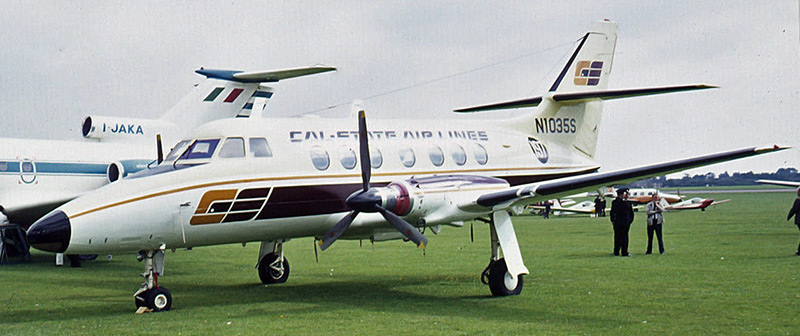
On 12th June 1971 she participated in the Daily Express National Air Race, flying from Sywell to Biggin Hill, with race number 197. Back in those days the media still considered that aviation was actually of interest to the public and the race start and finish were televised on the BBC’s Grandstand sports programme. The prize was £1,000 and the Daily Express Challenge Trophy, and 50 aircraft took part. N1035S, happily for us at Sywell, won the race! Flight Magazine noted that “The Jetstream Mkl flown by Capt Bill Bright, streaked dramatically past the finishing line like a hunted fox” The race trophy was presented to Bill Bright by Douglas Bader and Prince William of Gloucester at Biggin Hill.
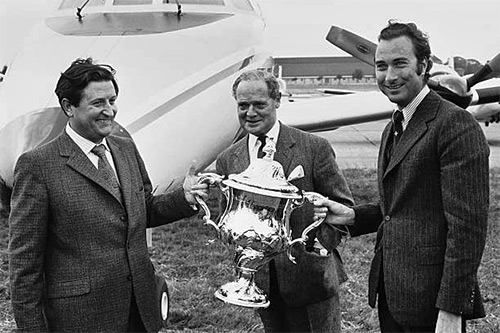
Her American registration was finally cancelled on 21st February 1974 and she returned to being G-AVWK, now owned by Decca in the form of Racal Decca Navigator Ltd. They had the aircraft stripped down for a major inspection and maintenance period, with the engines returned to the manufacturers in France for overhaul. Racal then used her as a demonstrator and development test bed for the Decca Navigator equipment, equipped with a Decca Danac pictorial display and Navigator Mk.15. She was later fitted with a TANS computer and Doppler 72, along with an ADL 81 Loran C receiver.
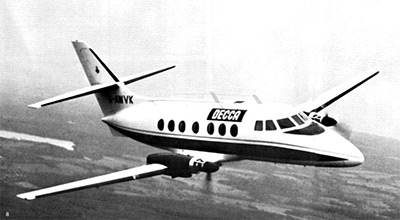
Racal found that ‘Victor Kilo’ was a surprisingly flexible aircraft. Accordingly, as well as being a test bed she also carried out her intended purpose of passenger transport (just taking 3 to 5 company employees to their destinations was cheaper than paying for airline tickets for them) and even cargo carriage, with the cabin interior being able to be reconfigured from airborne test bed with equipment racks to passenger config to cargo config in just a few hours. By 1986 was also fitted with wingtip pods (we found the now-disused extensive wiring to these whilst dismantling the aircraft). Decca, meanwhile, had merged with Racal and undergone a change of name and were now called Racal Avionics Ltd, so on 2nd December 1986 they re-registered her to match as G-RAVL.
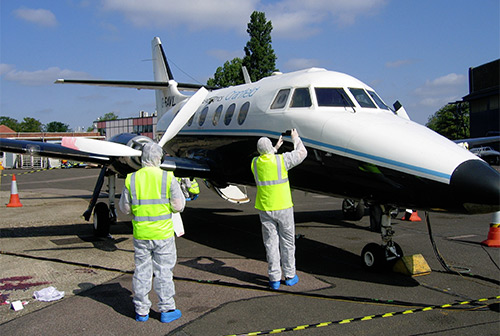
On 22nd November 1989 the Cranfield College of Aeronautics acquired her (initially on lease) as an aerial classroom and test bed. Sadly the aircraft arrived with time on the engines nearly expired. The college could not find the required £300,000 to replace them so once the remaining time on the engines was used up, the aircraft was retired in the late 1990s and on 30th January 2001 was de-registered as having been withdrawn from use. In fact she continued to be of use, and carried on being used by the now-University of Cranfield as a ground teaching aid for their Accident Investigation Courses. She was finally retired and put into open storage at Cranfield in the late 2010s.
Operation Moonraker – thefts, a pandemic and wing bolts!
In 2018 the Sywell Aviation Museum decided to look for a new airframe to add to its collection. With the retirement of the RAF’s Tornado fleet, we held some tentative discussions with the MoD, involving local MPs, to see if we could acquire a Tornado. These proved fruitless and in any event we wondered what we would do with another jet – and how could we use it?
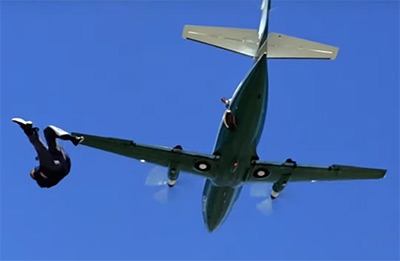
Thoughts then turned to other machines with a Sywell link. Unfortunately when one thinks of aeroplanes linked to the airfield, many are fabric covered and wouldn’t last long outside. Then we thought about a Jetstream, which could be a much more practical and useful proposition as we could actually let people inside it. By this point G-RAVL was sitting outside and unloved on a disused taxiway at Cranfield. She was spotted on the UK Aircraft Wrecks and Relics Facebook page and contact was made with the University regarding her future. Cranfield University is of course a world-reknowned seat of aeronautical learning and has a history of helping aeroplanes into preservation. Pleased that RAVL could find a good home other than the scrapman, the University kindly agreed to donate her to us!
We believe G-RAVL to be the third oldest surviving Jetstream in existence and was the aircraft on the production line right next to c/n 209, the famous Apollo Airways Jetstream used in the opening sequence of the Bond movie Moonraker… so we now had a codename for the project. What’s a single digit between friends? Once we’d looked into her history and found she had some Sywell connection, she had to be the one!
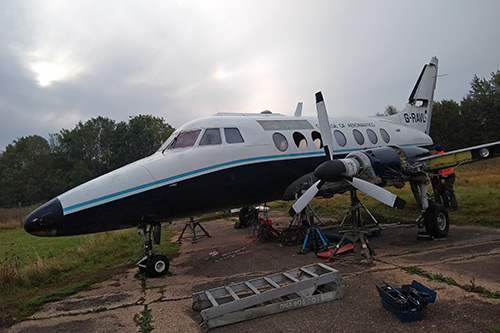
Our first visit to see her was on the 18th December 2018 to gain an appreciation of the size of the task that awaited us. With the approval of the Museum Committee, work started in July 2019 when she was towed ‘non airside’ for work to begin on dismantling her for her new life at Sywell. The fact that it then took nearly 2 years to actually make the move speaks volumes and there were many points at which we nearly gave up. Handley Page clearly never intended for their work to be taken apart and Jetstream wing spars are notoriously difficult to access and work on. Extensive depanelling took place and then, on turning up to work on the aircraft in early October 2019, we were devastated to find she had been broken into and several items stolen including instruments, windows, the pilot’s seat cushions and even a NO SMOKING sign. This was hugely demoralising, and after securing the entrance door and putting in blanks to fill the empty window holes and keep the weather out, work continued on dismantling her until Covid-19 hit and effectively put the whole project on hold.

Work carried on sporadically during 2020, as possible, with her tailplane and elevator, wing control surfaces and propellers being removed for transport and making their way to Sywell, the closed Museum providing a hiding place for the bits of our secret project! The recaltritant wing bolts, however, kept up their fight. We had intended to await the end of Covid restrictions to complete the movement of the aircraft itself but then word came that Cranfield needed the dispersal pan on which she sat for a new building project.
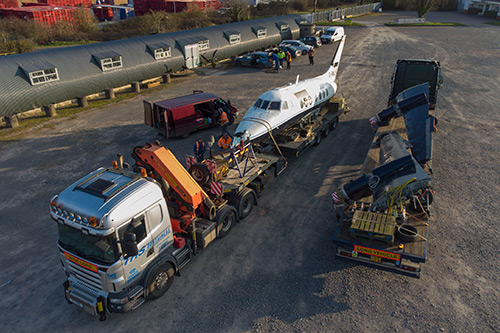
She had to be moved by the end of March. So, on 23rd March 2021 the transport was booked and – after a final 5 hour battle with even more wing bolts and associated gubbins – her wings were finally removed and loaded onto one trailer while the fuselage was loaded on another. The short trip up the M1 had her arriving at Sywell an hour or so later, where she was offloaded and had her wings put back on (with fewer bolts!) just as the sun went down on what had become a very long day.
So what are our plans? Well the Museum has taken over 16000 young people round the aerodrome over the last 20 years and we need a classroom! We have never before been able to put children inside an aeroplane and the Jetstream will be perfect for that – she is even equipped with an integral airstair in her entrance door so is easy to access for the able-bodied.
We need your help!
So what’s next? We need the following to restore her:
- Passenger seats
- Interior panels
- Fuselage windows
We are looking for someone or a company to help trim her out inside since as part of her use as a training aid her interior aft of the cockpit has been completely stripped out. If your company can help with retrimming and fitting out her interior we can proudly put your logo on her fin!
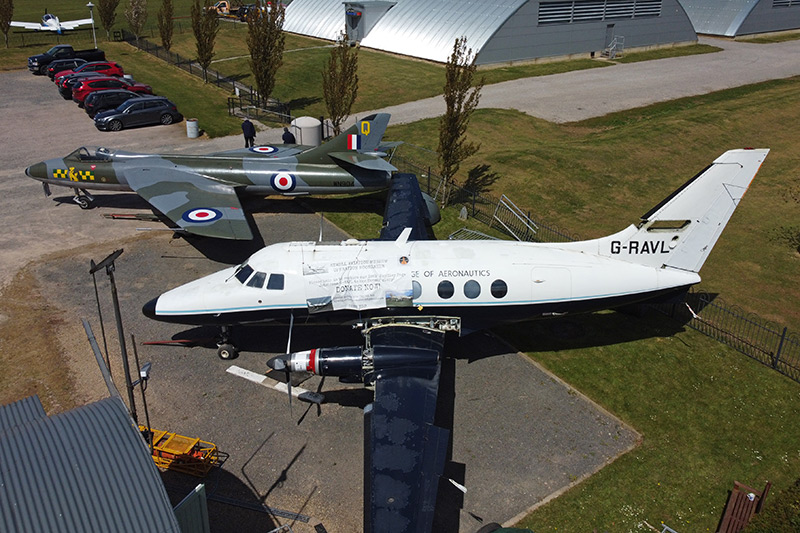
And we need your support – moving her was the biggest and most expensive project the Museum has ever undertaken – if you would like to donate please contact us or we welcome your Paypal donations direct to sywellaviationmuseum@gmail.com
When fitted out inside and repainted she will wear a refreshed colour scheme of G-RAVL on one side with Cranfield titles and G-AWVK on the other with Racal Decca titles, with the addition of the ‘197’ race number she wore in June 1971. She will be a much valued asset to the Museum and will improve what we can offer to you – our visitors – especially our younger ones – and we have saved a piece of British aviation heritage which otherwise would have gone for scrap (and was at genuine risk of doing so!).

National Transport Trust Restoration Award 2024
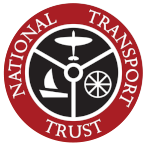
We are delighted to announce that the Museum won a National Transport Trust Restoration Award for our ongoing restoration of our 1969 Handley Page Jetstream 200 G-RAVL ‘Jenny’ which was presented by HRH Princess Anne.
We are absolutely delighted and not a little humbled to have received an award in such illustrious company – the breadth of projects across the UK is absolutely amazing and this is a huge feather in our cap for such a little Museum.
Thanks
We would like to record our thanks to The University of Cranfield, Cranfield Aviation Operations, Dave Thomas, Naylan Moore , South Yorkshire Air Museum, THS Containers – Glyn & Dan, all at Sywell Aerodrome air traffic and fire/fuel crews and finally to Air Leasing (especially Richard Grace, Matt, Marcus and Anthony).